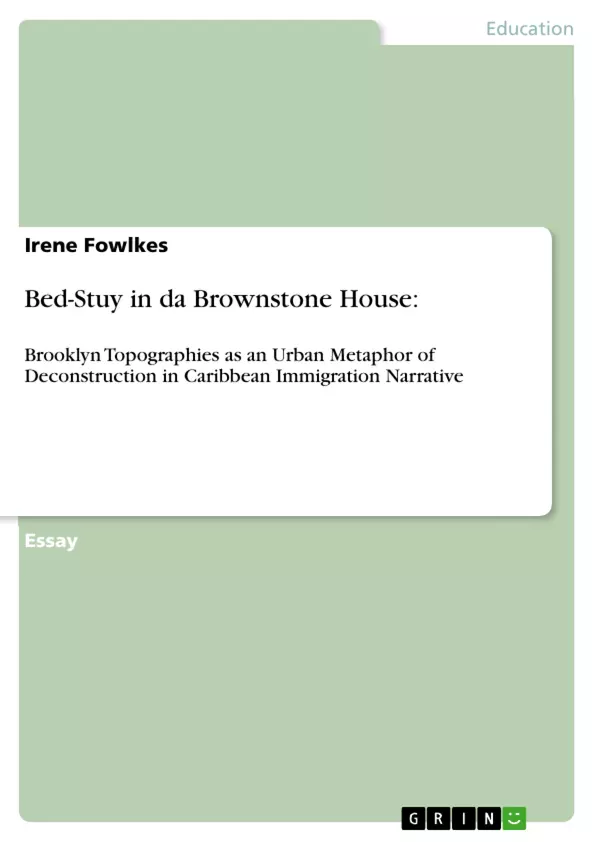For the purpose of a contribution to the critical text volume of the Afro-American diaspora,'Brown Girl, Brownstones' is read as a Bildungsroman, rather than an ethnic study, whereas certain terms of sociological discourse pertaining to class, gender and race are elaborated upon. The novel concerns the first generation Barbadian-American girl Selina Boyce, who grows up in the Bedford-Stuyvesant section of Brooklyn during the Depression and the Second World War. Exploring the immigrant experience of Selina’s family through two major narrative strands, whereas the first primarily treats her parents' domestic conflict and the second is devoted to the protagonist’s coming of age, the novel is held together by the artful depiction of New York City topographies. As characteristic of the entire story, the beginning is constituted by a powerful personification of the brownstone houses, which are typical for Bed-Stuy, as the neighborhood is affectionately called by locals; contributing to its nostalgic charm.
Both, the structure and significance of the work are sustained by the creation of socio-psychological meaning through the relationship of the plot with its characters and spatial images that translate into symbolism. Whereas Selina’s consciousness is primarily defined by the atmosphere of the city, her parent’s attitudes are still influenced in various ways by their past childhood on the Caribbean islands.
The family’s search for a new home in the urban north of the United States is traced by highlighting the architectural metaphors of New York City in the novel. Special consideration is given to the beautiful Bed-Stuy brownstone story houses, Prospect Park, Fulton Street in downtown Brooklyn and industrial Williamsburg as well as bohemian Greenwich Village in Manhattan. Less a conceptualization of dualities, as it can be found often in the secondary literature about Paule Marshall’s first work of prose, my interpretation aims to support the idea of an urban metaphor of deconstruction. Consequently, the romantic myth of New York City is put into question, as the protagonist rises to independence against the backdrop of development projects and embarks on her own version of the American dream.
Table of Contents
- Introduction: Topographies as an all encompassing metaphor
- Character of Brooklyn brownstones and introduction of the protagonist
- The family conflict: Land versus home
- Theoretical reflection upon gender issues in the novel
- Topographies 1: Fulton Park
- Fulton Street / 125th Street in Harlem and the social meaning of city streets
- Prospect Park and the Brooklyn Public Library at Grand Army Plaza
- Williamsburg / “Berliniamsburg”
- Politics of Space: Social meaning of the stoop
- The "City of Women" and the West Indian Carnival in Brooklyn
- Topographies 2: The Upper West Side and City College of CUNY
- Greenwich Village
- The Upper East Side
- Conclusion: City projects and individual rise to independence
Objectives and Key Themes
This work examines Paule Marshall's novel "Brown Girl, Brownstones" through the lens of urban topographies as a central metaphor. The objective is to analyze how the novel's narrative is interwoven with the physical spaces of New York City, exploring the immigrant experience and the protagonist's journey of self-discovery. Key themes explored in the text include:- The significance of brownstone houses in shaping the lives of Barbadian immigrants in Bed-Stuyvesant, Brooklyn.
- The role of urban spaces and neighborhoods in defining identity and belonging for both immigrants and the protagonist, Selina Boyce.
- The intersection of class, race, and gender within the context of the immigrant experience in 1930s and 1940s New York City.
- The struggle between tradition and modernity, as reflected in the clash between the immigrant generation's past and Selina's coming-of-age experience.
- The evolving nature of New York City and its impact on individual lives and the American dream.
Chapter Summaries
The text begins by establishing the central role of brownstone houses in shaping the lives of Barbadian immigrants in Bed-Stuyvesant. The text analyzes the symbolic significance of these structures as a constant amidst change, a space both familiar and alien for the protagonist. The text then delves into the complex relationship between Selina and her family, highlighting the conflict between her parents' traditional values and her desire for independence. This chapter explores how the family's search for a new home reflects the wider narrative of immigration and social mobility in the United States. The text goes on to analyze the social meaning of different city streets and public spaces, including Fulton Street in Brooklyn, Prospect Park, and Williamsburg. These spaces are examined as sites of cultural encounter, social mobility, and individual growth.Keywords
This work examines Paule Marshall's "Brown Girl, Brownstones" through the lens of urban topographies, immigrant experience, identity formation, class, race, gender, cultural encounter, social mobility, and the American dream.- Quote paper
- Irene Fowlkes (Author), 2006, Bed-Stuy in da Brownstone House: , Munich, GRIN Verlag, https://www.grin.com/document/127590



